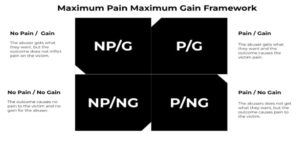6 Tips to Survive an Abuser’s Tactics of Maximum Pain, Maximum Gain
How to come out ahead when an abuser wants to hurt you and win at all costs
Julie Nee and Lisa Aronson Fontes, PhD
After separation, many abusers want to punish their ex-partners as much as possible. They try to take everything they can—often including the children.
This is a post-separation coercive control tactic.
Unfortunately, coercive control abuse often intensifies post-separation. Since the mask of love is gone, the abuser’s tactics emerge in full force; centering around pain and gain.
The Abusive Strategy of Maximum Pain, Maximum Gain
Pursuing dominance, coercive controllers aim for “maximum pain, maximum gain.” Abusers manipulate the victim’s emotions and behaviors to achieve their own ends.
This strategy leads to four main types of outcomes:

Abuser Tactic Type 1: Pain / Gain
For example, an abuser might convince a judge to give them more parenting time, but then they neglect the child on visits. This has been called spiteful disregard – harming a child to “get back at” the child’s other parent. The goal of hurting the ex is more important than anything else. The abusers get what they want, and also cause their victim pain.
Abuser Tactic Type 2: No Pain / Gain
Abusers get what they want without causing their partner significant pain. These are the attempts to “win” that cause ex-partners to roll their eyes because they seem so petty. For instance, an abuser removes two door handles which he had previously installed before turning over the marital home to his former wife upon divorce. Or an abuser “accidentally” breaks their victim’s favorite mug while moving out, just because they can. Abusers feel like they have gained by exerting control over the situation and demonstrating their ability to “win.”
Abuser Tactic Type 3: Pain / No Gain
The coercive controller inflicts maximum pain on their partner but does not receive their desired outcome. This shows up most often when a father triangulates and weaponizes children against their mother, harming the mother/child relationship. (Most often, mothers are the primary parent and the protective parent). The abuser’s actions here cause the mother pain, but do not actually benefit the abuser. In fact, as the children get older, they often begin to perceive the patterns and resent the abusive parent.
Abuser Tactic Type 4: No Pain / No Gain
The abusers do not get what they want, and they do not cause their ex-partner direct pain. However, even though they do not win in this scenario, they may be able to inflict pain later. For example, if the coercive controller isn’t invited to a social event with mutual friends, they may publicly humiliate the ex-partner on social media or through shared contacts by sharing intimate information or stories. They will always find ways to punish.
6 Tips to Avoid These Abusive Tactics
Abusers use this strategy because it gets them what they want: control and punishment. They learned in the relationship that if they can cause their partner enough pain, their partner will submit to their demands.
The good news? Once you are separated, you do not have to put up with this anymore. There are a few things you can do to guard yourself from the abuser’s strategy of Maximum Pain / Maximum Gain.
1. Let go of everything that doesn’t really matter, but don’t do it right away; that’s too easy. The abuser will just come looking for more. So, for example, you might negotiate hard on the issue of having your child for Thanksgiving. But eventually give it up in exchange for something that is more important to you, such as being with your child on Valentine’s Day or their birthday, or bringing your child to an annual family reunion. Then celebrate Thanksgiving on the weekend before or after Thanksgiving Thursday, when your child is with you. Focus on your most essential goals.
2. Avoid thinking that abusers will behave reasonably or show empathy because they won’t. We want to believe that ex-partners will treat us kindly, do what is best for the child, follow the judges’ orders, and be satisfied when they have “enough.” But it’s never enough. As long as it is possible for abusers to “get” more and inflict more pain—they will.
3. Be prepared for the pain, especially if you “win.” For example, a judge may award you the marital home in a divorce. But the abuser may break the appliances before you get back in. Also, see if your local police will help you scan the house for hidden cameras and listening devices.
4. Learn how to employ Yellow Rock communication. This involves avoiding explaining yourself or getting into a back-and-forth discussion about past events while focusing on the matter at hand. Yellow Rock is similar to the Grey Rock method, or not giving an abuser any type of reaction or rebuttal. Yellow rock is responding only in a calm and even friendly manner, with the idea that any communication could be used against you. Not reacting also shows an abuser you cannot be provoked. Over time, the coercive controller will see that they are not getting a reaction out of you. Any reaction adds fuel to their fire.
5. Avoid contact as much as possible. If the abuser pushes your boundaries, just follow the judge’s orders and stay firm. Don’t succumb when the abuser pressures you to “be nice” by allowing them to attend holidays, or the children’s events on your parenting time. If you have a protective order, keep it. Remember, though, that if you demand that your ex avoid attending the child’s events during your parenting time, you will have to do the same on their parenting time—even if it means that you miss certain sports events, performances, etc.
6. Join with others who have similar experiences. HAVEN Program offers monthly support groups for survivors!

While the abuser’s goal is to inflict maximum pain and gain everything, your objective is the opposite: minimize their impact and maximize your own (and your children’s) well-being. The true gain lies in reclaiming your life and emotional freedom.
HAVEN Advocates are here to help you reclaim your life and emotional freedom!
Thanks for reading!





